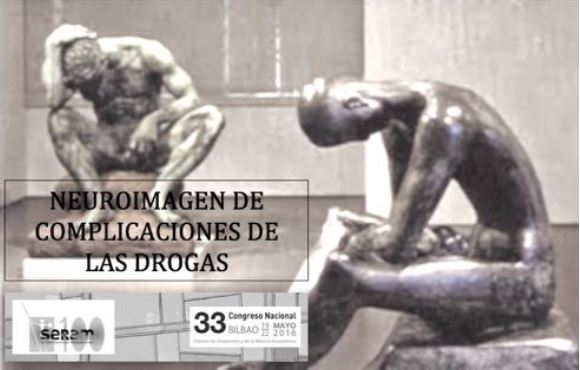Complicaciones neurológicas de las drogas de abuso.
Palabras clave:
Complicaciones neurológicas, poster, seram, drogas de abuso, drogasResumen
Objetivos Docentes
Revisar las drogas con mayor repercusión neurológica (cocaína, heroína, MDMA, alcohol y cannabis) especificando su efecto bioquímico, mecanismo fisiopatológico principal y patrón de consumo habitual.
Ilustrar las complicaciones cerebrales agudas y los efectos a largo plazo con técnicas de imagen convencional (TC, RM y angiografía) y repasar los últimos avances que el PET y el SPECT han mostrado en relación a cambios de metabolismo y perfusión.
Revisión del tema
NEUROIMAGEN DE LAS COMPLICACIONES DE LAS DROGAS.
INTRODUCCIÓN:
El consumo de drogas adictivas constituye un gran problema socioeconómico y de salud, con una alta morbimortalidad asociada. Tradicionalmente la neuroimagen ha tenido un papel secundario limitado a la detección de eventos vasculares agudos. Actualmente el radiólogo ha adquirido un papel importante en el diagnóstico de las complicaciones de instauración brusca y en los efectos deletéreos a largo plazo debido al avance en el conocimiento de la enfermedad y a su representación con técnicas convencionales, imagen basada en la funcionalidad del cerebro y al creciente desarrollo de biomarcadores.
Descargas
Citas
Brown E, Prager J, Lee HY, et al. CNS complications of cocaine abuse: prevalence, pathophysiology, and neuroradiology. AJR Am J Roentgenol 1992;159:?137– 47.
Fessler RD, Esshaki EM, Stankewitz RC, et al. The neurovascular complications of cocaine. Surg Neurol. 1997;47:339–345.
Cregler LL, Mark H. Medical complications of cocaine abuse. N Engl J Med. 1986;315:1495–1500.
Daras M, Tuchman AJ, Koppel BS, et al. Neurovascular complications of cocaine. Acta Neurol Scand. 1994; 90:124–129.
Dackis CA, Dackis MA, Martin D, et al. Platelet serotonin transporter in cocaine patients. NIDA Res Monogr. 1984; 55:164–169.
- Kelly P, Philip SJ, Ritchie IO. Acute cocaine alters cerebrovascular aurorregulation in the rat neocortex. Brain Res Bull. 1993;31:581–585.
- Mena JC, Cuellar H, Vargas D, et al. PET and SPECT in drug and substance abuse. Top Magn Reson Imaging 2005;16:253–56.
Nolte KB, Gelman BB. Intracerebral hemorrhage associated with cocaine ?abuse. Arch Pathol Lab Med 1989;113:812–13 ?
Rojas R, Riascos R, Vargas D. et al. Neuroimaging in drug and substance abuse. Part I. Cocaine, cannabis, and ecstasy. Top Magn Reson Imaging 2005;16: 231–38
Borne J, Riascos R, Cuellar H, et al. Neuroimaging in drug and substance abuse. Part II. Opioids and solvents. Top Magn Reson Imaging 2005;16:239 – 45
Geibprasert S, Gallucci M, Krings T. Addictive illegal drugs: structural neuroimaging. AJNR Am J Neuroradiol 2010;31(5):803–808.
Tamrazi B, Almast J. Your brain on drugs: imaging of drug-related changes in the central nervous system. Radiographics. 2012;32(3):701-19
McEvoy AW, Kitchen ND, Thomas DG. Intracerebral haemorrhage and drug ?abuse in young adults. Br J Neurosurg 2000;14:449 –54 ?
Kaufman M. Brain Imaging in Substance Abuse: Research, Clinical and Forensic Applications. Totowa, New Jersey: Humana Press; 2001.
Volkow ND, Fowler JS, Wang GJ, et al. Dopamine in drug abuse and addiction: results from imaging studies and treatment implications. Mol Psychiatry. 2004;9:557–569.
Volkow ND, Wang GJ, Fowler JS, et al. Association of methylphenidate-induced craving with changes in right striato-orbitofrontal metabolism in cocaine abusers: implications in addiction. Am J Psychiatry. 1999;156: 19–26.
Trescot AM, Datta S, Lee M, et al. Opioid pharmacology. Pain Physician 2008; S133–153.
VolkowND, Valentine A, Kulkarni M. Radiological and neurological changes in the drug abuse patient: a study with MRI. J Neuroradiol 1988;15:288 –93 44.
Brust JC, Richter RW. Stroke associated with addiction to heroin. J Neurol Neurosurg Psychiatry 1976;39:194 –99.
Andersen SN, Skullerud K. Hypoxic/ischaemic brain damage, especially pallidal lesions, in heroin addicts. Forensic Sci Int 1999;102:51–59.
Dehaven RN, Mansson E, Daubert JD, et al. Pharmacological characterization of human kappa/mu opioid receptor chimeras that retain high affinity for dynorphin A. Curr Top Med Chem. 2005;5:303–313.
Bartlett E, Mikulis DJ. Chasing “chasing the dragon” with MRI: leukoencephalopathy in drug abuse. Br J Radiol 2005;78(935):997–1004.
Pezawas LM, et al. Cerebral CT findings in male opioid-dependent patients: stereological, planimetric and linear measurements. Psychiatry Res. 1998;83:139–147.
Johnston, LD., O’Malley, PM., Bachman, JG., et al. Monitoring the future national survey results on drug use in Secondary school students. National Institute on Drug Abuse; 2007. 1975-2006: Volume I
Chang L, Cloak C, Patterson K, et al. Enlarged striatum in abstinent methamphetamine abusers: a possible compensatory response. Biol Psychiatry 2005;57:967–974.
Cowan RL, Lyoo IK, Sung SM, et al. Reduced cortical gray matter density in human MDMA (ecstasy) users: a voxel-based morphometry study. Drug Alcohol Depend 2003;72:225–235
McCann UD, Szabo Z, Scheffel U, et al. Positron emission tomographic evidence of toxic effect of MDMA (‘‘Ecstasy’’) on brain serotonin neurons in human beings. Lancet. 1998;352:1433–1437.
Spampinato V, Castillo M, Rojas R, et al. Magnetic resonance imaging findings in substance abuse: alcohol and alcoholism and syndromes associated with alcohol abuse. Top Magn Reson Imaging. 2005;16(3):223-30.
Heinrich A, Runge U, Khaw V. Clinicoradiologic subtypes of Marchiafava-Bignami disease. J Neurol. 2004;251:1050–1059.
Gambini A, Falini A, Moiola L, et al. Marchiafava-Bignami disease: longitudinal MR imaging and MR spectroscopy study. AJNR Am J Neuroradiol. 2003;24:249-253.
Moussouttas M. Cannabis use and cerebrovascular disease. Neurologist. 2004;10:47–53.
Mateo I, Pinedo A, Gomez-Beldarrain M, et al. Recurrent stroke associated with cannabis use. J Neurol Neurosurg Psychiatry. 2005;76:435–437.
Jones RT. Cardiovascular system effects of marijuana. J Clin Pharmacol. 2002;42(11 suppl):58S–63S.
Geller T, Loftis L, Brink DS. Cerebellar infarction in adolescent males associated with acute marijuana use. Pediatrics. 2004;113:e365–e370.
Wilson W, Mathew R, Turkington T, et al. Brain morphological changes and early marijuana use: a magnetic resonance and positron emission tomography study. J Addict Dis. 2000;19:1–22.
Chang L, Grob CS, Ernst T, et al. Effect of ecstasy (MDMA) on cerebral blood flow: a co-registered SPECT and MRI study. Psychiatry Res. 2000;98:15–28.


